The Fundamental Unit of Life Summary Class 9 Science Chapter 5
Introduction
- The cell is the structural and functional unit of life. It is the basic unit of life.
- It was discovered by Robert Hook in 1665 in a cork slice with the help of a primitive microscope.
- Leeuwenhoek (1674) discovered the free-living cells in pond water with an improved microscope.
- Robert Brown discovered the nucleus in the cell in 1831.
- Purkinje coined the term ‘protoplasm’ for the fluid substance of the cell in 1839.
The Cell Theory
- The theory that all plants and animals are composed of cells and the cell is the basic unit of life was presented by two biologists, Schleiden and Schwann.

- Virchow further expanded the cell theory by suggesting that all cells arise from pre-existing cells.
Types of organisms
On the basis of no. of cells, organisms are of two types:
Unicellular Organism: These organisms are single-celled and perform all their functions.
Example: Amoeba, paramecium, bacteria.
Multicellular Organism: Many cells grouped together to perform different functions in the body and also form various body parts. Example: fungi, plants, animals.
- The shape and size of cells are different according to the kind of function they perform. There is division of labour in cells.
- Each cell has certain kind of cell organelles to perform different types of functions like mitochondria for respiration.
Types of cells
- There are two types of cells:
- Prokaryotes
- Eukaryotes
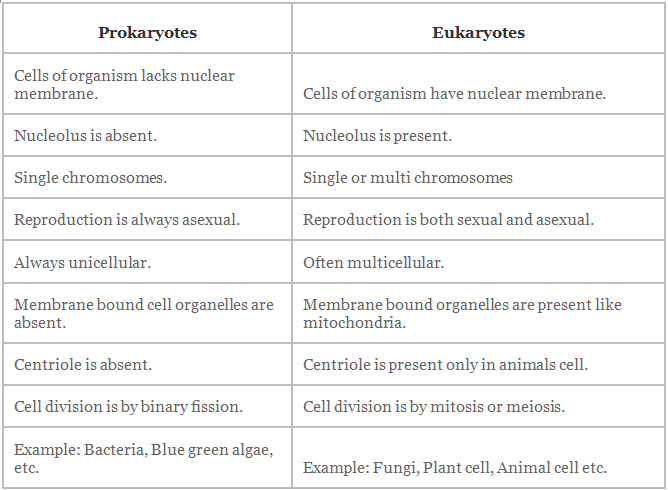
Difference between Animal cell and Plant cell
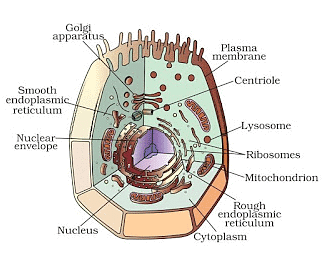
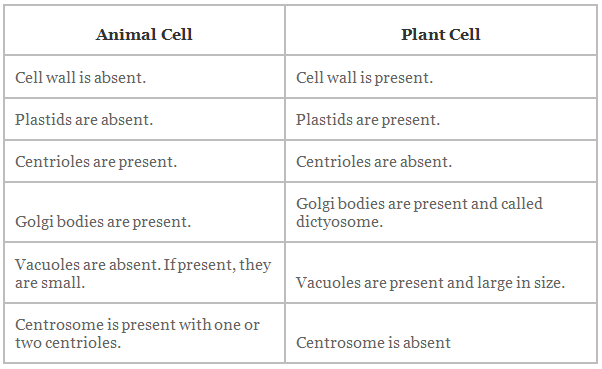
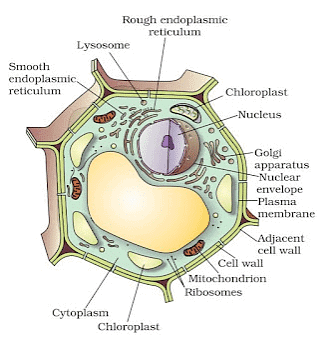
Diffusion
- The spontaneous movement of a substance from a region of high concentration to the region of low concentration is called diffusion.
- Some substances like carbon dioxide or oxygen can move across the cell membrane by a process called diffusion. The cell also obtains nutrition from the environment.
Osmosis
- The movement of water molecules through selectively permeable membrane along the concentration gradient is called osmosis.
- Plant cell tend to obtain water through osmosis.
Hypotonic or Hypertonic or Isotonic Solution
What happened to cell in sugar or salt solution?
Plasma membrane or Cell membrane
- This is the outermost covering of the cell that separates the contents of the cell from its external environment.
- The plasma membrane allows or permits the entry and exit of some materials in and out of the cell.
- It also prevents movement of some other materials. The cell membrane is called selectively permeable membrane.
- It is made up of lipid and protein.
Properties of Plasma membrane
- It is flexible (made up of organic molecules called lipids and proteins).
- Its flexibility enables cell to engulf in food and other from the external environment. This process is called endocytosis. Amoeba acquire food through this process.
Functions of Plasma membrane
- It permits the entry and exit of some materials in and out of the cell.
- It prevents movement of some other materials not required for the cell as it acts like selectively permeable membrane.
Cell Wall
- Cell wall is another rigid outer covering in addition to the plasma membrane found in plant cell. The cell wall lies outside the plasma membrane.
- The plant cell wall is mainly composed of cellulose. Cellulose is a complex substance which provides structural strength to plants.
Function of Cell Wall
- Cell walls permit the cells of plants, fungi and bacteria to withstand very dilute (hypotonic) external media without bursting.
- In such media the cells tend to take up water by osmosis. The cell swells, building up pressure against the cell wall. The wall exerts an equal pressure against the swollen cell.
- Because of cell wall, cells can withstand much greater changes in the surrounding medium than animal cells.
Plasmolysis
When a living plant cell loses water through osmosis there is shrinkage or contraction of the contents of the cell away from the cell wall. This phenomenon is known as plasmolysis.
Nucleus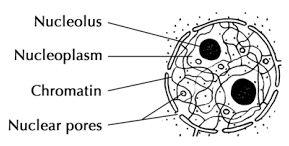
- It is called the brain of the cell as it controls all the activities of cell.
Composition of Nucleus
- The nucleus has a double layered covering called nuclear membrane.
- The nuclear membrane has pores which allow the transfer of material from inside the nucleus to the cytoplasm.
- The nucleus contains chromosomes, which are visible as rod-shaped structures only when the cell is about to divide.
Functions of chromosomes
- Chromosomes contain information for inheritance of features from parents to next generation in the form of DNA (Deoxyribose Nucleic Acid) molecules. Chromosomes are composed of DNA and protein.
- DNA molecules contain the information necessary for constructing and organising cells.
- Functional segments of DNA are called genes.
- In non-dividing cell, this DNA is present as part of chromatin material.
- Chromatin material is visible as entangled mass of thread like structures. Whenever the cell is about to divide, the chromatin material gets organised into chromosomes and perform cell division.
Functions of Nucleus
- The nucleus plays a central role in cellular reproduction. It is the process by which a single cell divides and forms two new cells.
- It also plays a crucial part, along with the environment, in determining the way the cell will develop and what form it will exhibit at maturity, by directing the chemical activities of the cell.
Nucleoid
- In some organisms like bacteria, the nuclear region of the cell may be poorly defined due to the absence of a nuclear membrane.
- Such an undefined nuclear region containing only nucleic acids is called a nucleoid.
Cytoplasm
- The cytoplasm is the fluid content inside the plasma membrane.
- It also contains many specialised cell organelles. Each of these organelles performs a specific function for the cell.
Function of Cytoplasm
- It helps in exchange of material between cell organelles.
- It act as store of vital chemicals such as amino acid, glucose, vitamins and iron etc.
- It is the site of certain metabolic pathways such as glycolysis.
Endoplasmic Reticulum (ER)
- The endoplasmic reticulum (ER) is a large network of membrane-bound tubes and sheets.
- It looks like long tubules or round or oblong bags (vesicles).
- The ER membrane is similar in structure to the plasma membrane. It is also made up of lipid and proteins.
Types of Endoplasmic Reticulum
- Rough endoplasmic reticulum (RER)
- Smooth endoplasmic reticulum (SER)
Functions of Endoplasmic Reticulum
- RER looks rough under a microscope because it has particles called ribosomes attached to its surface. The ribosomes, which are present in all active cells, are the sites of protein manufacture. The manufactured proteins are then sent to various places in the cell depending on need, using the ER.
- The SER helps in the manufacture of fat molecules, or lipids, important for cell function.
- Some of these proteins and lipids help in building the cell membrane. This process is known as membrane biogenesis.
- Some other proteins and lipids function as enzymes and hormones.
- Although the ER varies greatly in appearance in different cells, it always forms a network system.
- One function of the ER is to serve as channels for the transport of materials (especially proteins) between various regions of the cytoplasm or between the cytoplasm and the nucleus.
- The ER also functions as a cytoplasmic framework providing a surface for some of the biochemical activities of the cell.
- In the liver cells of the group of animals called vertebrates, SER plays a crucial role in detoxifying many poisons and drugs.
Golgi Apparatus
- The Golgi apparatus consists of a system of membrane-bound vesicles arranged approximately parallel to each other in stacks called cisterns.
- These membranes often have connections with the membranes of ER and therefore constitute another portion of a complex cellular membrane system.
Function of Golgi Body
- The material synthesised near the ER is packaged and dispatched to various targets inside and outside the cell through the Golgi apparatus.
- Its functions include the storage, modification and packaging of products in vesicles. In some cases, complex sugars may be made from simple sugars in the Golgi apparatus.
- The Golgi apparatus is also involved in the formation of lysosomes.
Lysosomes
- Lysosomes are a kind of waste disposal system of the cell.
- It helps to keep the cell clean by digesting any foreign material as well as worn-out cell organelles.
- Lysosomes have membrane-bounded structure whose sacs are filled with digestive enzymes.
Functions of Lysosomes
- Lysosomes break foreign materials entering the cell, such as bacteria or food as well as old organelles into small pieces.
- They contain powerful digestive enzymes which are made in RER which is capable of breaking down all organic material made in RER.
- During the disturbance in cellular metabolism such as when the cell gets damaged, lysosomes may burst and the enzymes digest their own cell. Therefore, lysosomes are also known as the ‘suicide bags’ of a cell.
Mitochondria
- Mitochondria are known as the powerhouses of the cell.
Structure of mitochondria
- Mitochondria have two membrane coverings.
- The outer membrane is very porous while the inner membrane is deeply folded.
- These folds create a large surface area for ATP-generating chemical reactions.
Functions of mitochondria
- The energy required for various chemical activities needed for life is released by mitochondria in the form of ATP (Adenosine triphosphate) molecules.
- ATP is known as the energy currency of the cell. The body uses energy stored in ATP for making new chemical compounds and for mechanical work.
- Mitochondria have their own DNA and ribosomes. Therefore, mitochondria are able to make some of their own proteins.
Plastids
- Plastids are present only in plant cells.
- There are three types of plastids:
- Chromoplasts (coloured plastids).
- Leucoplasts (white or colourless plastids).
- Chloroplasts (contains the pigment chlorophyll).
Structure of Plastids
- The internal organisation of the plastids consists of numerous membrane layers embedded in a material called the stroma.
- Plastids also have their own DNA and ribosomes like mitochondria and similar to its structure.
Function of Plastids
- Chloroplasts are important for photosynthesis in plants.
- Chloroplasts also contain various yellow or orange pigments in addition to chlorophyll.
- Leucoplasts are primarily organelles in which materials such as starch, oils and protein granules are stored.
Vacuoles
- Vacuoles are storage sacs for solid or liquid contents.
- They are small sized in animal cells while plant cells have very large vacuoles.
Function of vacuoles
- The central vacuole of some plant cells may occupy 50-90% of the cell volume.
- In plant cells vacuoles are full of cell sap and provide turgidity and rigidity to the cell.
- Many important substance in the life of the plant cell are stored in vacuoles which include amino acids, sugars, various organic acids and some proteins.
- In single-celled organisms like Amoeba, the food vacuole contains the food items that the Amoeba has consumed.
- In some unicellular organisms, specialised vacuoles also play important roles in expelling excess water and some wastes from the cell.
|
28 videos|68 docs|33 tests
|
FAQs on The Fundamental Unit of Life Summary Class 9 Science Chapter 5
| 1. What is the basic structural and functional unit of life? |  |
| 2. What are the two main types of cells? |  |
| 3. What is the function of the cell membrane? |  |
| 4. What is the role of organelles in a eukaryotic cell? |  |
| 5. How do cells reproduce? |  |






















